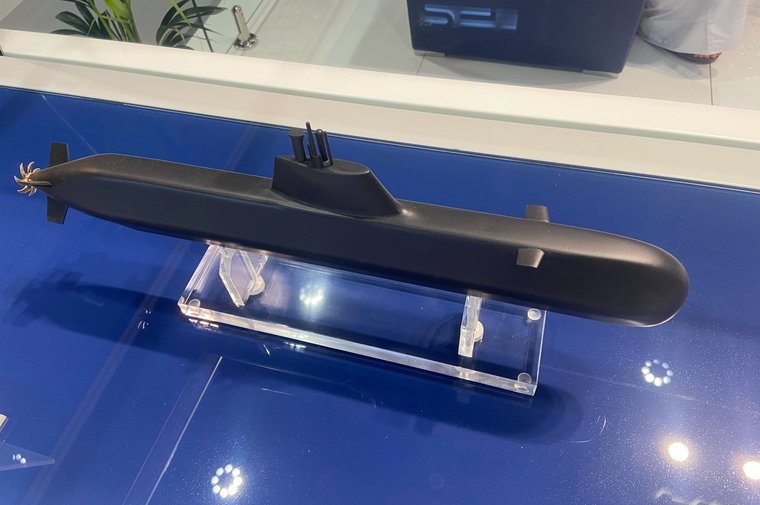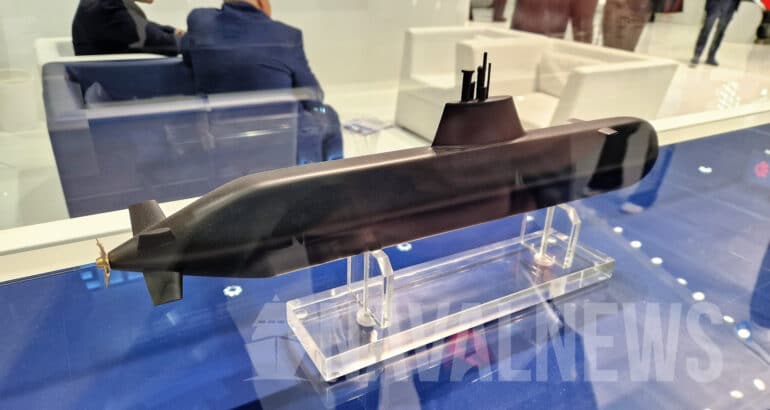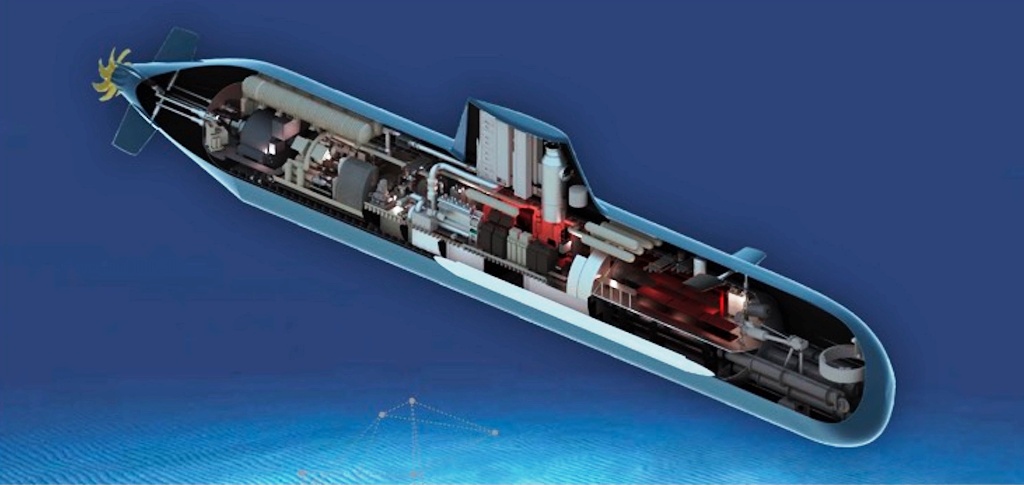The SC
ELITE MEMBER

- Joined
- Feb 13, 2012
- Messages
- 32,233
- Reaction score
- 21
- Country
- Location
24th February 2023

Presented at NAVDEX in Abu Dhabi, the S800 is pitched as a middle-of-the-market boat between midget submarines and larger designs.
Italian shipbuilder Fincantieri is offering its S800 small submarine to Pakistan to meet its naval requirements.
Suited for ASW, intelligence-gathering and maritime security missions, the submarine is designed to operate in shallower waters with a small crew of just 18.
The S800 represents an additional option for larger navies that need smaller assets to patrol coastal areas, relieving larger SSKs from those tasks, or for tier-two navies that lack the capability to operate larger platforms.
The S800 also presents an interesting option for navies looking to dip their toes into submarine operations without procuring large traditional boats.
The submarine has been developed with low maintenance and high automation in mind.

Shephard understands the platform has been proposed to Pakistan to meet its vessel requirements.
The Italian shipbuilder is fully open to transfer of technology (ToT) agreements, which Islamabad would likely be keen on, building on the experience in partnerships with France, Turkey and China.
The submarine design has reportedly also drawn interest from countries in the Gulf region.
With shallow waters, the Fincantieri submarine could be an attractive and more affordable option for Gulf countries looking to develop their underwater capabilities.
Fincantieri is understood to have discussed the product as part of Doha and Rome’s ongoing shipbuilding relationship.
From a technical perspective, the S800 has a submerged displacement of 850t. Measuring 51m in length, according to Fincantieri, the platform has an operational depth of 250m. Powered by AIP in different configurations, the boat can reach a maximum speed of over 15kt.
Like most modern submarines, the sail has no fins and features an optronic non-penetrating mast, with two small fins placed in the higher part of the hull.
The S800 can be fitted with an external payload on the aft deck for special forces operations, such as CABI Cattaneo’s Deep Guardian shelter.
Offensive capabilities come in the form of five tubes for weapons like the Leonardo Black Shark torpedo.
The submarine is understood to share several components with Italy’s new U212NFS platform, ranging from the EW suite to the boat’s combat management system.
https://www.navalnews.com/event-new...ils-s800-coastal-and-shallow-water-submarine/

The S800 has been developed to meet all main requirements for mission in the littoral environment, and at the same time provide comparable performance of conventional submarines operating in blue waters to more than 250 meters depth.
Conceived on the basis of concepts, experiences and technologies developed with the U212 and U212NFS programmes, and smaller platforms envisaged by Fincantieri in order to operate in shallow waters, the S800 Light Submarine is characterized by a compact design with an overall length of 51 meters, a pressure hull diameter of 4.80 meters and a total height (including mast) of 10 meters, alongside an automated platform control system with four ‘X’ stern rudders and forward hull-positioned hydroplanes, enabling the submarine to perform very tight maneuvers and follow the sea bottom contour.
With a surfaced (ready to dive) and submerged displacement of respectively 750 and 850 tonnes, the S800 Light Submarine is characterized by a diesel-electric with AIP (Air Independent Propulsion) propulsion system featuring a 12-cylinders turbocharged V-batt diesel engine with synchronous generator, and a permanent magnet excitation electric motor driving a propeller group with a 3 meters diameter, and two batteries banks, alongside two Fuel Cells Modules with a maximum output power of 70 kWe each.
According to Fincantieri the introduction of an AIP plant on small underwater platforms allows a ‘very high submerged endurance’ by means of conventional diesel-electric propulsion, as well as reducing to zero the indiscretion ratio; the estimated endurance is seven days of submerged patrol, while at the same time the extremely quiet operation of the Fuel Cells system guarantees keeping the acoustic signature at minimum.
A very low signature was reached by the optimization of the acoustic and non-acoustic signature to avoid ASW detection. With an operational depth of 250 meters and a maximum submerged speed of over 15 knots, the underwater endurance on batteries at 4.5 knots and AIP at the same operating speed is indicated respectively in over 200 and 700 nm, while autonomy reaches the 4,500 nm with snorkel and batteries, and overall endurance is respectively of 30 and approximately 7 days, in the latter case with AIP.

With a crew of 18 among officers and crew and the capability to carry a team of eight SOF operators, the S800 is being promoted by Fincantieri with a combat system based on four multifunctional consoles (three devoted to the combat system and one to the platform control) and a sonar suite including a passive flank array sonar, a passive cylindrical array sonar, an active array, an active obstacle avoidance sonar, alongside a passive cylindrical intercept array sonar. The sensors suite also includes an attack periscope, a search optronic mast, communications and navigation radar masts, an EW suite with a RESM antenna on periscope, as well as an underwater telephone, alongside torpedo countermeasures system.
With a five swim-out pneumatic torpedo tubes, the S800 Light Submarine weapons load consists of five heavy-weight torpedoes in the launchers, and four plus one in the torpedo room, allowing a maximum inventory of nine (plus one) weapons. The latter are expected being Leonardo Black Shark Advanced (BSA) heavyweight torpedoes.
Thanks to its size and hull characteristics the S800 is the operationally most suitable strategic asset for supporting Special Forces missions, providing the capability to release and recovery two chariots in fully covert operations, according to Fincantieri.
https://www.edrmagazine.eu/fincantieri-takes-a-model-of-the-s800-light-submarine-at-idex-navdex-2023
Weapon capabilities:
The submarine can launch Leonardo and Black Shark torpedoes through five tubes
- Displacement 850 tons
- Length 51 metres
- Maximum speed: 15 knots
- AIP

Presented at NAVDEX in Abu Dhabi, the S800 is pitched as a middle-of-the-market boat between midget submarines and larger designs.
Suited for ASW, intelligence-gathering and maritime security missions, the submarine is designed to operate in shallower waters with a small crew of just 18.
The S800 represents an additional option for larger navies that need smaller assets to patrol coastal areas, relieving larger SSKs from those tasks, or for tier-two navies that lack the capability to operate larger platforms.
The S800 also presents an interesting option for navies looking to dip their toes into submarine operations without procuring large traditional boats.
The submarine has been developed with low maintenance and high automation in mind.

Shephard understands the platform has been proposed to Pakistan to meet its vessel requirements.
The Italian shipbuilder is fully open to transfer of technology (ToT) agreements, which Islamabad would likely be keen on, building on the experience in partnerships with France, Turkey and China.
The submarine design has reportedly also drawn interest from countries in the Gulf region.
With shallow waters, the Fincantieri submarine could be an attractive and more affordable option for Gulf countries looking to develop their underwater capabilities.
Fincantieri is understood to have discussed the product as part of Doha and Rome’s ongoing shipbuilding relationship.
From a technical perspective, the S800 has a submerged displacement of 850t. Measuring 51m in length, according to Fincantieri, the platform has an operational depth of 250m. Powered by AIP in different configurations, the boat can reach a maximum speed of over 15kt.
Like most modern submarines, the sail has no fins and features an optronic non-penetrating mast, with two small fins placed in the higher part of the hull.
The S800 can be fitted with an external payload on the aft deck for special forces operations, such as CABI Cattaneo’s Deep Guardian shelter.
Offensive capabilities come in the form of five tubes for weapons like the Leonardo Black Shark torpedo.
The submarine is understood to share several components with Italy’s new U212NFS platform, ranging from the EW suite to the boat’s combat management system.
https://www.navalnews.com/event-new...ils-s800-coastal-and-shallow-water-submarine/

The S800 has been developed to meet all main requirements for mission in the littoral environment, and at the same time provide comparable performance of conventional submarines operating in blue waters to more than 250 meters depth.
Conceived on the basis of concepts, experiences and technologies developed with the U212 and U212NFS programmes, and smaller platforms envisaged by Fincantieri in order to operate in shallow waters, the S800 Light Submarine is characterized by a compact design with an overall length of 51 meters, a pressure hull diameter of 4.80 meters and a total height (including mast) of 10 meters, alongside an automated platform control system with four ‘X’ stern rudders and forward hull-positioned hydroplanes, enabling the submarine to perform very tight maneuvers and follow the sea bottom contour.
With a surfaced (ready to dive) and submerged displacement of respectively 750 and 850 tonnes, the S800 Light Submarine is characterized by a diesel-electric with AIP (Air Independent Propulsion) propulsion system featuring a 12-cylinders turbocharged V-batt diesel engine with synchronous generator, and a permanent magnet excitation electric motor driving a propeller group with a 3 meters diameter, and two batteries banks, alongside two Fuel Cells Modules with a maximum output power of 70 kWe each.
According to Fincantieri the introduction of an AIP plant on small underwater platforms allows a ‘very high submerged endurance’ by means of conventional diesel-electric propulsion, as well as reducing to zero the indiscretion ratio; the estimated endurance is seven days of submerged patrol, while at the same time the extremely quiet operation of the Fuel Cells system guarantees keeping the acoustic signature at minimum.
A very low signature was reached by the optimization of the acoustic and non-acoustic signature to avoid ASW detection. With an operational depth of 250 meters and a maximum submerged speed of over 15 knots, the underwater endurance on batteries at 4.5 knots and AIP at the same operating speed is indicated respectively in over 200 and 700 nm, while autonomy reaches the 4,500 nm with snorkel and batteries, and overall endurance is respectively of 30 and approximately 7 days, in the latter case with AIP.

With a crew of 18 among officers and crew and the capability to carry a team of eight SOF operators, the S800 is being promoted by Fincantieri with a combat system based on four multifunctional consoles (three devoted to the combat system and one to the platform control) and a sonar suite including a passive flank array sonar, a passive cylindrical array sonar, an active array, an active obstacle avoidance sonar, alongside a passive cylindrical intercept array sonar. The sensors suite also includes an attack periscope, a search optronic mast, communications and navigation radar masts, an EW suite with a RESM antenna on periscope, as well as an underwater telephone, alongside torpedo countermeasures system.
With a five swim-out pneumatic torpedo tubes, the S800 Light Submarine weapons load consists of five heavy-weight torpedoes in the launchers, and four plus one in the torpedo room, allowing a maximum inventory of nine (plus one) weapons. The latter are expected being Leonardo Black Shark Advanced (BSA) heavyweight torpedoes.
Thanks to its size and hull characteristics the S800 is the operationally most suitable strategic asset for supporting Special Forces missions, providing the capability to release and recovery two chariots in fully covert operations, according to Fincantieri.
https://www.edrmagazine.eu/fincantieri-takes-a-model-of-the-s800-light-submarine-at-idex-navdex-2023
Weapon capabilities:
The submarine can launch Leonardo and Black Shark torpedoes through five tubes
- Displacement 850 tons
- Length 51 metres
- Maximum speed: 15 knots
- AIP




